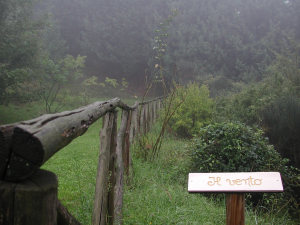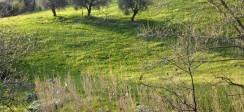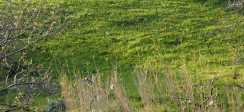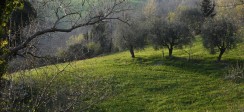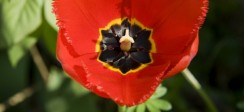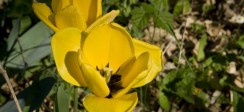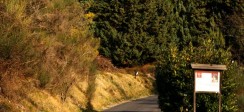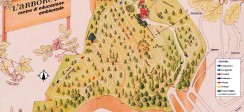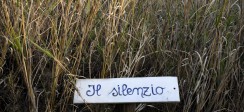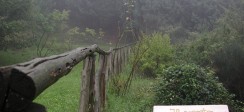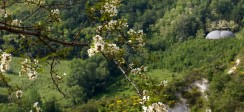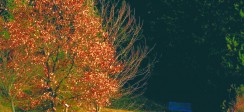An arboretum is not a simple park, but a botanical garden dedicated to trees and shrubs. An organized system aiming at the study, growth and preservation of precious and possibly endangered species and ecotypes.
The experimental arboretum of Mondaino, was inaugurated and opened to the public in Spring of 1990. Today, this open-air laboratory collects about 6000 plants.
That’s why we found it natural to associate education and environment, particularly in the interest of the children. For them the arboretum is a space where nature can be experienced through play, art and creativity.
In the park you can listen to the soundscape; you can create toys or little characters with the forest’s natural “leftover” materials; you can smell and touch.
You can look up or leave your footprints on the ground, chase shadows or hide among the trees. You can find a spot that is totally still, a ladybird, a butterfly and a feeling you may want to draw, once back at school.
Furthermore the Environmental Education Centre (CEA – Centro di Educazione Ambientale) is a place that can host important research projects in collaboration with universities. A group of qualified professionals, a lecture room, a thematic collection of the arboreal species and a specialized library are at the disposal of visitors.
Through the trails of the arboretum
In Autumn 2001 our association re-opened seven forest trails. Walking along those trails you can spot some well-defined areas. Among the most interesting ones, from the point of view of the natural landscape, the oak woods, the riparian vegetation (growing along the “Tafuggia” ditch) and the thickets. They are all typical elements of the gullies that once were agricultural lands, found in the areas in the outskirts of Rimini. The Genista is among the most common species of shrubs found here.
In the section dedicated to the Pinaceae we mostly find pine and cedar trees, along with a good number of other conifers, which, although not always in good vegetative conditions, are anyway interesting from an educational point of view.Along the windy trail at the centre of the arboretum, we have a chance to observe and study various arboreal species – divided into different beds – that normally don’t grow in this area, all belonging to the oak family.
Finally, we find various species that are typical of the Mediterranean scrub which although alien to the local landscape, are in very well kept vegetative conditions.
Trails:
L’impronta (The footprint)
Lo sguardo (The look)
L’ombra (The shadow)
Il silenzio (The silence)
Il fosso (The ditch)
Il vento (The wind)
Il nascondiglio (The hiding place)
The park: a resource for the good of all
Respect for nature is a must. In order to heighten our environmental awareness, we only need to adopt a few small tactics. We refrain from making loud noises and from any act of vandalism.
We don’t ride bicycles a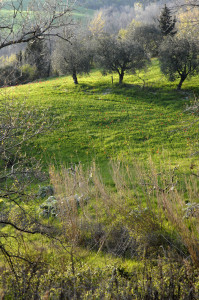 nd motorcycles on the lawn and along the forest trails. We don’t pick flowers, we don’t break off branches from the trees, we don’t make engravings on tree trunks.
nd motorcycles on the lawn and along the forest trails. We don’t pick flowers, we don’t break off branches from the trees, we don’t make engravings on tree trunks.
Pets should be kept on a leash and under the owner’s surveillance.
If we get the opportunity to see wild animals, we should behave with respect and discretion, trying not to disturb nor scare them, and without chasing them. Let’s take this chance to enjoy remaining in silence, instead.
If we use the picnic area we should clean up after ourselves. We avoid throwing garbage on the ground, even in case of biodegradable waste; we neither try to burn it nor to bury it, but we use the appropriate waste bin. We don’t start fires, especially not on windy days. Fire spreads easily.
It is advisable to wear appropriate clothing to walk on the trails (and shoes have their importance too). We suggest you to take the trail map with you and a camera: when we are in nature we can take the time for a break from all other devices of our technological civilization.
Photo Gallery
Various tree species
Rosaceae
1. Biancospino 2. Melo selvatico 3. Ciliegio 4. Susino 5. Lauroceraso
6. Pesco 7. Prugnolo 8. Agazzino 9. Pero selvatico 10. Rosa selvatica
11. Rovo 12. Sorbo domestico
Fagaceae
13. Castagno 14. Faggio 15. Cerro 16. Quercia spinosa 17. Leccio
18. Rovere 19. Roverella 20. Farnia 21. Quercia da sughero
Ulmaceae
22. Bagolaro 23. Olmo campestre 24. Olmo della roccia
Aceraceae
25. Acero campestre 26. Acero negundo 27. Opalo 28. Acero riccio
29. Acero di monte 30. Acero atropur.
Oleaceae
31. Frassino maggiore 32. Orniello 33. Ligustro lucido 34. Ligustro cinese
35. Olivo 36. Olivastro 37. Lillà
Cornaceae
38. Sanguinella 39. Corniolo
Betulaceae
40. Ontano napoletano
Buxaceae
41. Bosso
Corylaceae
42. Carpino bianco 43. Carpinella 44. Nocciolo 45. Carpino nero
Caprifoliaceae
46. Sambuco 47. Viburno
Pinaceae
48. Abete bianco 49. Abete della Cilicia 50. Cedro dell’Atlante 51. Cedro dell’Himalaya
56. Pino bosniaco 57. Pino nero 58. Pino marittimo 59. Pino domestico
60. Pino ponderoso 61. Pino strobo 62. Pino silvestre 63. Douglasia
Leguminoseae
64. Falso indaco 65. Albero di Giuda 66. Vesicaria 67. Maggiociondolo
68. Robinia 69. Ginestra odorosa
Cupressaceae
70. Cipresso comune 71. Ginepro coccolone 72. Cipresso di Monterey
73. Cipresso d’Arizona 74. Cipresso di Lawson 75. Redcedar occidentale 76. Tuia orientale
Graminaceae
77. Canna comune
Ranuncolaceae
78. Vitalba
Elaeagnaceae
79. Olivagno 80. Olivello spinoso
Moraceae
81. Fico
Celastraceae
82. Fusaggine
Lauraceae
83. Alloro
Juglandaceae
84. Noce
Salicaceae
85. Pioppo bianco 86. Pioppo nero 87. Pioppo tremolo
88. Salice bianco 89. Salicone
Rhamnaceae
90. Giuggiolo
Taxaceae
91. Tasso
Aquifoliaceae
92. Agrifoglio
Tiliaceae
93. Tiglio selvatico 94. Tiglio nostrano
Malvaceae
95. Ibisco
Bignoniaceae
96. Catalpa
Anacardiaceae
97. Scotano
Arialiaceae
98. Edera
Ginkgoaceae
99. Ginkgo
Pittosporaceae
100. Pittosporo
« L’arboreto Edizioni SCRITTURE PER LA DANZA CONTEMPORANEA – I° Biennio (2009-2010) »

